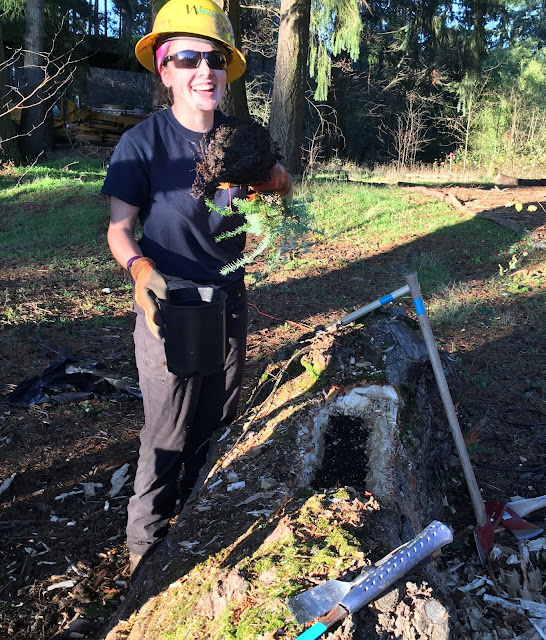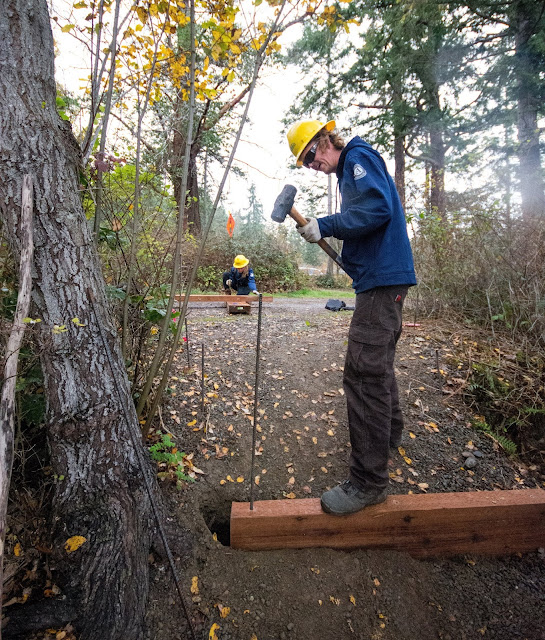 |
| Part of our Kirkland crew gathers around the nurse log they created. Photo by Kelli Sheldon. |
Simulated nurse log boosts educational accessibility in King County
City of Kirkland is a new year-long partner for WCC and members are supporting the city’s Green Kirkland Partnership during their 11-month term. The program features collaboration between City of Kirkland, nonprofit partners, businesses, and the community to work toward restoring and maintaining more than 500 acres of urban parks and green spaces across the city.Among our Kirkland crew’s first projects was a unique chance to support both education and physical accessibility efforts in the city’s McAuliffe Park. AmeriCorps members created a simulated nurse log in a more accessible space to educate the public about traditional old growth forest elements.
“A nurse log is a fallen tree that creates a nutrient rich habitat for young seedlings as it decays,” said crew supervisor Kelli Sheldon. Having a nurse log labeled in a public park affords people the opportunity to learn about ecosystem benefits they provide without requiring visitors hike on technical or uneven trail terrain.
AmeriCorps members started the project with a large poplar tree log. Members used handsaws, circular saws, and Pulaskis (a hand tool used to fight wildfires) to form a small trench on the top of the log. Then they planted a hemlock tree and red huckleberry bush. Finally, they covered the log with a thick coating of moss that grows naturally on nurse logs and provided moisture for the freshly planted vegetation.
 |
| A WCC AmeriCorps member enjoys the sunshine as she plants the tree sapling. Photo by Kelli Sheldon |
“We served at one restoration site early in the year that was less than half an acre in size, yet we discovered and removed more than 10 different types of invasive species from that single site,” said AmeriCorps member Celia Thurman. “Not only was this a huge learning opportunity for the crew and me to learn how to identify these species, but I got to know how to manage each differently as well.”
This fall, members have supported restoration efforts at seven different Kirkland public parks, improving 1.5 acres for to benefit the public while planting 292 native trees and shrubs.
Isthmus Trail gets a lift in Kilisut Harbor
In November, AmeriCorps members serving North Olympic Salmon Coalition (NOSC) spent a week improving the Isthmus Trail at Kilisut Harbor in Jefferson County. Members improved 88 feet of the trail leading to the beach, including building more stairs and adding a railing to ensure public safety and accessibility for community members.“The crew groomed the remainder of the pathway leading to the beach so it was more clearly-defined and easier to traverse,” said AmeriCorps member Torin Blake.
 |
| AmeriCorps member Christian Akers installs rebar as part of the trail construction project. Photo contributed by Owen French. |
Members support salmon recovery along upper Yakima basin
WCC AmeriCorps members serving the Yakama Nation collaborated with Mid-Columbia Fisheries Enhancement Group (MFEG) in mid-October to plant native trees and shrubs along a section of the North Fork Teanaway River in Kittitas County. Since the area was first designated for restoration in 2011, the final phases of this restoration project are long time coming.In summer 2019, MFEG contracted to have several carefully engineered large woody debris structures installed in the river. The structures support salmon habitat by slowing water flow and creating small rearing pools ideal for juvenile salmon.
 |
| AmeriCorps member Isabel Casillas puts the finishing touches on a native tree along the North Fork Teanaway River. Photo by Laura Schlabach. |
To restore the spaces affected by heavy log-installation equipment, AmeriCorps members led nine volunteers from Trout Unlimited who served 54 hours planting native trees and shrubs. The native plants will help secure the soil and protect the river from erosion.
In nearby Cle Elum, members also planted 4,500 native trees and shrubs along the Yakima River in six days. The vegetation will prevent erosion and eventually improve salmon habitat by shading and cooling the water, making it more conducive for spawning.
Padilla Bay visitors learn about salmon life-cycle
In addition to field crew opportunities, WCC offers an internship program called the Individual Placement (IP) program. IP Izzi Lavallee serves as an education coordinator at the Padilla Bay National Estuarine Research Reserve in Skagit County. She is part of a team that teaches free monthly educational programs for Mini Explorers (ages 3 to 5) and Junior Ecologists (ages 6 to 9). |
| AmeriCorps
member Izzi Lavallee. Photo contributed by Izzi. |
“We learned about the importance of salmon ecologically and culturally, their role in the ecosystem, and the stages of their lifecycle. At the end of the class, I read ‘Salmon Creek’ by Annette LeBox and Karen Reczuch. It is a sonorous story about the lifecycle of salmon, told through the intimate lens of a particular Pacific wild salmon named Sumi,” she said.
The story concludes with Sumi completing her lifecycle and spawning her very own nest of eggs – known as redds. Izzi describes illustrations that beautifully capture eagles, otters, and bears feasting on the sea’s bounty, and poetic words that detail the creek’s fresh, earthy smell imprinting on Sumi’s eggs (the next generation of salmon who will return to spawn near the nest someday).
“The author leaves space for the audience to infer that Sumi has died,” Izzi said. “A little girl with a sad and concerned look on her face asked, ‘Did Sumi die?’”
Izzi responded by gesturing to the salmon life cycle they had all drawn on the board, and it dawned on the children that Sumi’s life ended.
Izzi asked the youngsters, “Who else was able to live on in the story?”
Many small faces turned hopeful, especially after a little girl replied, “The bear and the eagle and her babies got to live because of her sacrifice” while a young boy chimed in confidently, “The cycle continues forever and ever!”
“It made me tear up a bit,” Izzi reflected. “This is why we do place-based environmental education. These kids are making connections, developing an understanding of ecology, finding love and meaning in these ecosystems. These kids are our future. Given access to rich, nourishing education, these kiddos will grow into strong advocates, stewards and protectors for our salmon creeks, for our home.”
Members distribute salmon carcasses in Chiwawa River
Our Wenatchee Spike Crew spent the first half of October adding marine-derived nutrients to the Chiwawa River using a method many likely would deem too stinky for their liking: tossing in dead salmon carcasses.WCC partner Cascade Columbia Fisheries Enhancement Group (CFEG) is leading the five-year Chiwawa River Nutrient Enhancement Project to give the local waterway a nutrient boost. Our AmeriCorps members quite literally carried the project in year two. During two back-to-back weeks, members carried 50-pound bags of condensed salmon carcasses (known as analogs or pellets) to dump into the beautiful Chiwawa River.
 |
| WCC
AmeriCorps members carry heavy bags of salmon analogs to distribute in the Chiwawa River. Photo contributed by CFEG. |
Wildlife are not the only ones who benefit from nutrient enhancement; the project afforded new AmeriCorps members an opportunity to get to know one another. Before hauling each 50-pound bag of salmon analog through a mile-long trek to the river, they cheered “for the fish!” to one another before lifting a bag.
AmeriCorps member Kevin Wooldridge reflected on his first spike experience. "For me, there was so much more to the project than just dumping pellets into the river," he said. "This was an opportunity to spend quality time with the members of my crew. Being able to share the experience together was one of the best parts of the Chiwawa River Nutrient Enhancement Project!"

No comments:
Post a Comment